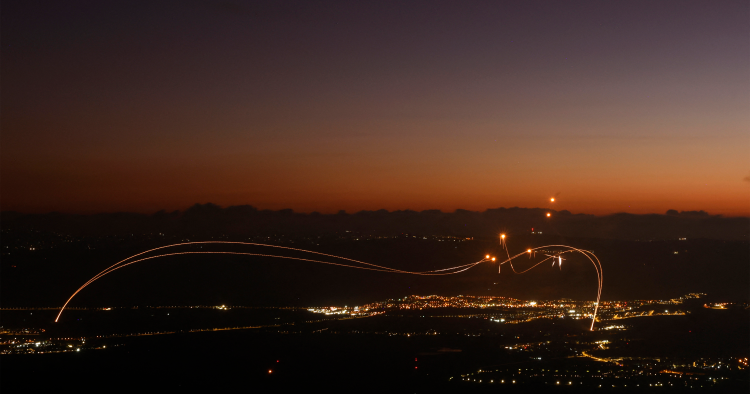Contents:
- After Hezbollah’s retaliation, no broader war for now, but the conflict drags on
- With a regional conflict averted for now, an Israel-Hezbollah war of attrition should not become the new normal
- America’s superficial political debate on the Middle East offers few practical solutions
- Continuity, not change, in Iran’s foreign policy under Pezeshkian
- Incremental normalization of the Taliban in Afghanistan: The UAE throws in its hat into the ring
After Hezbollah’s retaliation, no broader war for now, but the conflict drags on
Randa Slim
Senior Fellow and Director of Conflict Resolution and Track II Dialogues Program

-
Following Israel’s “pre-emptive strike” against Hezbollah military facilities and Hezbollah’s rocket and drone attacks, the two sides have engaged in a war of narratives, each trying to frame their respective operation as a success.
-
Given the continuing failure of the Gaza cease-fire talks, Hezbollah seems to be in a strategic trap of its own making: By linking the cessation of its war of support to a cease-fire deal, it has relegated the decision over when to end it primarily to the Israeli prime minister.
On Aug. 25, Hezbollah retaliated for Israel’s assassination of senior commander Fuad Shukr on July 30, launching 340 rockets and tens of drones from southern Lebanon and the eastern Beka’a region. According to Hezbollah Secretary-General Hassan Nasrallah, this was the first time its drones were launched into Israel from the Beka’a. Hezbollah’s retaliation started shortly after Israel undertook what it called a “preemptive strike,” in which 100 fighter jets targeted Hezbollah military sites, including rocket launching platforms, to thwart a larger attack that, according to Israeli officials, involved up to 6,000 rockets.
In the aftermath, both sides engaged in a war of narratives, each trying to frame their respective operation as a success. Israel’s success criterion was to thwart a larger Hezbollah attack. Nasrallah’s success criterion was that despite Israel’s pre-emptive strike, Hezbollah managed to carry out its own “limited” planned attack. It is not clear whether any of Hezbollah’s rockets and drones reached their targets; Israel maintains a media blackout and Nasrallah said Hezbollah needed time to find out.
In his post-retaliation speech on Aug. 25, Nasrallah offered four reasons for Hezbollah’s delayed response:
- It needed time to identify targets;
- It wanted to increase and prolong anxiety in Israel in anticipation of its response;
- The Iran-led Axis of Resistance needed time to decided how to respond to the assassinations of Shukr and Hamas political leader Ismail Haniyeh as well as the Israeli attack on the Houthi-controlled port of Hodeida in Yemen. In particular, they deliberated on whether the response should be collective or whether each party should choose the form and timing of its response individually. He said they decided on the latter; and
- Hezbollah wanted to give time and space for the ongoing Gaza cease-fire negotiations. He reiterated that a cease-fire deal remains its priority. Since Hezbollah has concluded that the negotiations are not going anywhere, Nasrallah said there was no reason to delay its response any longer.
Where do we go from here? Given the continuing failure of the Hamas-Israel negotiations in Doha and Cairo, the war started by Hezbollah on Oct. 8 in support of Hamas and the Palestinians is here to stay. Hezbollah is in a strategic trap of its own making. By linking the cessation of its war to a Gaza cease-fire deal, it has relegated the decision over when to end it primarily to the Israeli prime minister, who does not seem to be in any hurry.
As the conflict drags on without a clear roadmap of when and how it will end, Hezbollah’s war of support is facing diminishing returns. More than 400 of its commanders, including fairly senior cadres, have been assassinated. Swathes of Lebanon’s southern villages, long believed to be a Hezbollah stronghold, have been destroyed and their farmlands burned. More than 100,000 Lebanese, most of whom are Hezbollah constituents, have been displaced from their homes. Add to that the nearly 150,000 Lebanese civilians who still live within 10 km of the Blue Line and are caught in the daily crossfire between Hezbollah and Israel.
Outside of Hezbollah’s core constituency, the fairly strong backing for its war of support inside Lebanon is rapidly declining. It is no coincidence that in his Aug. 25 speech, Nasrallah sought to reassure listeners that a larger war is not happening and that people can go back to their normal lives.
The conflict dynamics on the Lebanese-Israeli front are thus back to where they were pre-July 30, before Shukr’s killing, with the daily exchange of cross-border fire and an ongoing Israeli assassination campaign targeting Hezbollah, Hamas, and lately Fatah commanders in Lebanon. For their part, Iran and the Houthis say they will carry out their own responses to the Haniyeh assassination and the Hodeida attack.
In his Aug. 25 speech, Nasrallah explained Hezbollah’s target selection criteria in detail, partly in an effort to establish rules of engagement with Israel. Whether Israel will heed them is yet to be seen. He spoke of three rules: No targeting of civilians, no targeting of infrastructure, and targeting of an Israeli military installation that was involved in the planning and execution of Shukr’s assassination. The latter is akin to Israel’s argument that Shukr was killed because he was responsible for the planning and execution of the July 27 Hezbollah attack on Majdal Shams in the Israeli-occupied Golan Heights. The Hezbollah retaliation playbook is eerily similar to the one Iran followed last April when it attacked Israel in response to the latter’s strike on its consulate in Damascus.
To date, neither Hezbollah nor Israel, nor their backers Iran and the US, wants an all-out war. Israeli Prime Minister Benjamin Netanyahu’s Aug. 25 statement that this latest episode is “not the end of the story,” coupled with the growing chorus of Israeli politicians and security figures calling for Israel to change the situation in the north and the fairly high levels of public support for military action against Hezbollah, might end up pushing Netanyahu, who has been reluctant to do so until now, into launching a large war on Lebanon. If past is prologue, such a move would likely end badly: Israel’s wars on Lebanon in 1982 and 2006 were the death knell for his predecessors’ careers.
Follow: @rmslim
With a regional conflict averted for now, an Israel-Hezbollah war of attrition should not become the new normal
Nimrod Goren
Senior Fellow for Israeli Affairs

-
Israel and Hezbollah, with the support of international actors, contained a volatile situation and made clear their preference to avert a broader regional conflict.
-
This does not end the war of attrition along the Israel-Lebanon border and does not bring an Israel-Hamas deal any closer; the US should step up its diplomatic efforts on these issues and seek new pathways forward.
Israel’s wait for Hezbollah to retaliate for the late July assassination of a senior commander in Beirut seems to have finally come to an end, and in a manner that has averted a regional war for now.
Once again, as has happened multiple times since Oct. 7, Israel and the Iran-led axis chose a course of action that does not lead to a full-fledged war. Iran postponed its retaliation for the assassination of Hamas’ political leader in Tehran; Hezbollah tried to respond against military targets, without targeting Israel's major cities; while Israel managed to foil most of the attack.
The course of events, and their quick containment, indicated that Israel and Hezbollah can indirectly communicate and coordinate, whenever an urgent need arises. They do so via public messaging that strikes the right tone and via third parties. Since their 2006 war, the two sides have developed a good understanding of each other.
But avoiding doomsday scenarios is not enough, as the reality on the ground has remained difficult since October 2023. A war of attrition is taking place, and the leaders of both Israel and Hezbollah are de facto willing for it to continue.
The price of this war is adding up. In Israel, tens of thousands have had to flee their homes. Communities and infrastructure have been shattered, and the sense of personal safety and trust in the state apparatus has dramatically declined.
As this continues, the risk of a regional war has not gone away. The war of attrition is gradually expanding; threats of further escalation are constantly voiced; and mishaps could lead to unintended consequences.
The situation along the Israel-Lebanon border urgently needs to be solved. US diplomacy managed to prevent further escalation but failed to put in place an arrangement to defuse tensions and enable citizens — on both sides — to return home.
The linkage between the Israel-Hezbollah conflict and the Israel-Hamas war remains intact. Therefore, mediation efforts toward a cease-fire in Gaza are carried out with an eye on the situation on the Israel-Lebanon border. But, as the last couple of weeks have made clear, the road to a cease-fire in Gaza still seems to be a long and winding one.
Fundamental gaps between Israel's Prime Minister Benjamin Netanyahu and Hamas' leader Yahya Sinwar have not gone away and are not easily bridged. Both are willing to engage with the mediation process, to deflect blame for failure, but their own political calculations still drive them away from a deal.
The intense cease-fire negotiations that took place in August were also a tool by the American, Egyptian, and Qatari mediators to hold back Iran and Hezbollah's retaliation against Israel. They provided ample time for diplomacy and coordination. They also ensured some relatively quiet weeks at an important time in US domestic politics.
Now that regional tensions seem to have been somewhat contained, the US should not lose interest in the never-ending talks on Gaza. It should also not be willing to settle for negotiations that drag on and on. The US should be willing to more effectively use its leverage and to publicly indicate what or who is actually blocking an agreement. In parallel, diplomatic efforts related to Israel-Lebanon should be intensified, to leverage the relative success of preventing an Israel-Hezbollah flare-up.
New pathways for Israel-Hezbollah de-escalation, which go beyond the existing linkage to a cease-fire in Gaza, should be crafted; "day after" plans for the Israel-Lebanon issue should be developed, much like multiple actors have been doing for Gaza; and discreet interaction between those in Israel and Lebanon who seek to seek a peaceful future should be enabled and fostered.
Follow: @GorenNimrod
America’s superficial political debate on the Middle East offers few practical solutions
Brian Katulis
Senior Fellow for US Foreign Policy

-
Democrats and Republicans have mostly avoided Middle East policy issues in the campaign, despite the important events happening in the region.
-
The Middle East Institute will continue to monitor the key regional policy positions staked out by the leading presidential candidates and present them in this online tracker in the run-up to the November elections.
The spotlight for US foreign policy in the Middle East remains focused on the efforts to achieve a cease-fire and hostage release deal between Israel and Hamas, as US diplomats continued to meet with regional counterparts over the weekend in Cairo to discuss the deal. The talks continued even as the conflict between Israel and Hezbollah in Lebanon flared up again, and worries about a widening regional war continue to cast a shadow.
With everything that’s going on in the Middle East, how much have these events shaped the political discussion in America, less than three months before the November elections? Not much at all.
It’s understandable why people in the Middle East closely watch what different political candidates in America say about the region, because America remains the most important, powerful, and influential external actor on events in that part of the world. But it is a mistake to confuse America’s leading role with its actual ability to determine outcomes, because the storyline of today’s Middle East is mostly written by various regional actors. It is also a mistake to assume that most voters in America care about these issues — a mistake easily made because some vocal and organized voices have as their main job making these issues seem to matter more than they do.
In addition, many Middle East specialists and policy advocates live in a bubble and spend most of their waking hours in echo chambers disconnected from the lives of ordinary voters, who are more concerned about the economy, abortion, immigration, education, and other issues that directly touch their lives.
That’s why it’s no surprise that the Middle East was barely mentioned in either political party platforms or in speeches at the two main political parties’ conventions this summer. For certain, different advocacy groups and constituents have tried to make Middle East policy issues matter more politically than they have in the past, but it just hasn’t worked. There are many reasons why the Democrats decided not to have a Palestinian speaker at their party convention last week, but a core consideration was the simple fact that political parties weeks before an election look to lift up voices that are seeking to elect their candidates, rather than those who do the opposite and threaten to defeat them. It’s a simple political calculus and that math is not hard to do.
That doesn’t mean Middle East issues are going away as a political matter. There are advocacy efforts aimed at lifting up the voices and concerns of people in the Middle East, and there are other advocacy groups that simply seek to use complicated regional dynamics as props in our own social and cultural divides, a form of neo-Orientalism. Candidates and their campaigns will also engage in the smoke and mirrors dance of pretending like they are actually listening to various advocacy groups, but more often than not, those engagements tend to be more about the “illusion of inclusion” than actual policy development for the next US administration.
One key area to watch is the impact that Middle East conflict and wars might have on global oil markets. Most American voters and their families feel the price of gasoline at the pump tangibly, and any widening of the current Middle East war could impact political dynamics in this year’s election, same as it ever was.
The United States remains the leading external actor in the Middle East, and for that reason, many will closely watch what the various political candidates have to say. The Middle East Institute put out this Middle East position tracker for the leading candidates earlier this month, and it will update it regularly before the elections in November. But it is important to keep in mind all the key caveats, especially the one that what a candidate says in seeking political office often bears very little relation to what that candidate does once in office, especially when it comes to the unpredictable Middle East.
Follow: @Katulis
Continuity, not change, in Iran’s foreign policy under Pezeshkian
Alex Vatanka
Director of Iran Program and Senior Fellow, Black Sea Program

-
In his first few weeks in office, Iranian President Masoud Pezeshkian has underdelivered on the foreign policy front, largely sticking to regime slogans after running a campaign in which he deplored Tehran’s international marginalization.
-
Pezeshkian knows that he cannot force his agenda on Ayatollah Ali Khamenei, but he might be able to persuade him — and the powerful Revolutionary Guards — about the merits of a less confrontational posture toward the outside world.
If the foreign policy rhetoric of Iran’s new president, Masoud Pezeshkian, leaves you bewildered, you’re not alone. Pezeshkian ran as a candidate who promised fundamental change, but in his first few weeks in the Office of the President, he has under-delivered, to put it mildly. In the realm of foreign policy, the man who as a candidate deplored Tehran’s marginalization on the international stage has pretty much stuck to the regime’s slogans, which reflect the worldview of Ayatollah Ali Khamenei, Iran’s supreme leader since 1989.
But it’s too early to give up on Pezeshkian and his government altogether. After all, changing course is a necessity for a regime beset by a long list of ailments, many of which are rooted in Tehran’s foreign policy choices. For Khamenei, Pezeshkian will not be as much of an instigator of change as he will be an implementor of policy shifts that the leader deems necessary.
Still, the personality of a president does matter in the Iranian system. In his second term, the over-confident Mahmoud Ahmadinejad tried, and failed, to force his agenda on Khamenei. Most notably, he sought to go over the head of the supreme leader in signaling to the Americans, a red-line for Khamenei.
In this effort to change course, Pezeshkian will play his cards very carefully. He knows that as president he cannot force his agenda on Khamenei, but he might be able to persuade the supreme leader — and the powerful Revolutionary Guards — about the merits of a less confrontational posture toward the outside world. This juggling act of preserving revolutionary idealism versus pursuing necessary pragmatism is on full display these days.
Wanting to pay homage to Khamenei’s desire for a pan-Islamic and revolutionary foreign policy, Pezeshkian last week lamented Muslim impotence in the face of Israeli policies. “If Muslims were united, would Israel have dared to commit these mistakes in this region? Not only Israel, but America, Europe, and any other power, could they do any of these things?” This is vintage sloganeering that is music to Khamenei’s ears and it means nothing in practice other than pretending that the mantle of Islamic leadership is within Tehran’s reach.
Pezeshkian’s foreign minister, Abbas Araghchi, has been given the role to pursue tangible results and not chase pipe dreams. Araghchi has made a few major statements so far, including:
- Iran will continue to prioritize ties with Russia and China;
- Iran will continue to support the Axis of Resistance and the struggle for Palestinian rights; and
- Iran will not try to revive the 2015 nuclear deal, but will look for ways to “manage” the tensions with the Americans to prevent war.
That all sounds like policy continuity in Tehran, but there is one exception. Araghchi also made a rather curious comment: that Iran will “prioritize” the Europeans if they are willing to end their hostile attitude toward the Islamic Republic, as he put it. Will this former deputy to Iranian Foreign Minister Javad Zarif be able to shift Tehran’s foreign policy in short order the way his former boss did in late 2013?
That remains to be seen. But no doubt Araghchi’s overture to the Europeans was pre-approved by Khamenei in the same exact way that Zarif got a green light in 2013 from supreme leader to pursue nuclear détente with the Western powers. The idea of prioritizing the Europeans, and not the Americans, demonstrates both the pressure Tehran is under to rebalance its foreign policy but also the regime’s overall limited ability to maneuver on the most sensitive of issues. After all, it is not Brussels but Washington that is the gatekeeper in Tehran’s efforts to reduce its marginalization on the international stage.
Follow: @AlexVatanka
Incremental normalization of the Taliban in Afghanistan: The UAE throws in its hat into the ring
Shanthie Mariet D'Souza
Non-Resident Scholar

-
On Aug. 22, the United Arab Emirates accepted the credentials of the Taliban's newly appointed ambassador to the Gulf state, following a similar move by China in January 2024.
-
The move is emblematic of a larger trend toward engagement in which all of Afghanistan’s neighbors now consider contact with the Islamic Emirate as expedient, in sharp contrast with the US and Western approach of isolating the Taliban.
On the face of it, it appears to be a short narrative comprising two high-profile visits resulting in a tight embrace.
On June 5, Sirajuddin Haqqani, the acting minister of interior affairs for the Taliban’s Islamic Emirate, landed in Abu Dhabi. A smiling Haqqani, who is a UN sanctioned “Specially Designated Global Terrorist,” carries a $10 million bounty from the United States State Department, and is wanted by the Federal Bureau of Investigation, shook hands with Sheikh Mohamed bin Zayed Al Nahyan, the president of the United Arab Emirates, as both posed for photographs. The official press release said Haqqani and bin Zayed “discussed strengthening the bonds of cooperation between the two countries and ways to enhance ties to serve mutual interests and contribute to regional stability.”
Less than two months later, on Aug. 17, Mullah Hasan Akhund, the Taliban prime minister, accompanied by Anas Haqqani (also a Specially Designated Global Terrorist and the brother of Sirajuddin Haqqani), met with bin Zayed during a visit to Abu Dhabi. Akhund’s first foreign trip since the group's return to power in Afghanistan in August 2021 was officially for medical treatment but was used by the Taliban and the UAE to shore up their bilateral ties.
Just five days later, on Aug. 22, the UAE accepted the credentials of Mawlawi Badr al-Din al-Haqqani, the Taliban's newly appointed ambassador to the oil-rich Gulf Arab state. This is a major diplomatic coup for the Taliban, especially in a country that had previously deployed troops as part of the coalition forces to counter the Taliban in Afghanistan (albeit largely in a peacekeeping capacity). Following the accreditation, the UAE announced that it would increase development and humanitarian aid, as well as investment in Afghanistan.
The UAE’s action — by all means a formal recognition of the Islamic Emirate — follows that of China, which in January 2024 became the first country to accept a Taliban ambassador, while evading the question of whether the move amounted to formally recognizing the Islamic Emirate. At the time, the Taliban spokesperson nevertheless boasted, “China has understood what the rest of the world has not.”
Digging deeper into the UAE’s decision uncovers similar security concerns and interest in the economic opportunities that the Islamic Emirate offers as motivated China. Additionally, regional dynamics, especially the UAE’s rivalry with Qatar, shape what is unmistakably the soft and incremental normalization of the Islamic Emirate by a strong ally of the United States.
It is also emblematic of a larger trend toward engagement in which all of Afghanistan’s neighbors now consider contact — formal or otherwise — with the Islamic Emirate as expedient. This regional approach, by communist/authoritarian regimes, monarchies, and even democracies, is in sharp contrast with the American and Western effort to isolate the Taliban.
Over the years, the latter’s isolationist position seems to have reached a dead end. With all its obdurate and expanding regressive policies on girls and women, and its newfound confidence to ban the UN special rapporteur on human rights in Afghanistan from entering the country, the Islamic Emirate has firmly consolidated itself. If it continues to play its cards well, including by granting favors to those who have recognized it, more countries could follow suit.
Follow: @shanmariet
The Middle East Institute (MEI) is an independent, non-partisan, non-for-profit, educational organization. It does not engage in advocacy and its scholars’ opinions are their own. MEI welcomes financial donations, but retains sole editorial control over its work and its publications reflect only the authors’ views. For a listing of MEI donors, please click here.













